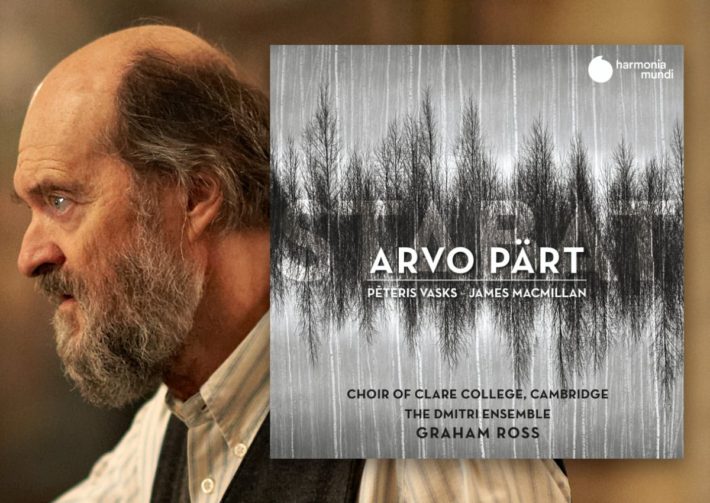Image: ©️ Kaupo Kikkas
The Choir of Clare College, Cambridge, and their conductor Graham Ross have turned to Arvo Pärt for their latest album. The Estonian’s dark, minimalist, “tintinnabuli” (or bell-like) style is present throughout, a style with which two additional contemporary works by Peteris Vasks and James MacMilan contrast nicely.
Pärt’s Stabat Mater, heard here in the version for string orchestra and S.A.T. choir, is the album’s stated focal point. The Dmitri Ensemble, providing three to five strings per part, introduces the piece, playing with a bare, visceral sound that grounds the entire performance. The choir’s entrance in the first verse is among the more exciting moments, creating a strong drive. But the music struggles to maintain its momentum as Pärt’s writing becomes more inscrutable, with bare soli lines and odd counterpoint. I wanted more subtlety from the choir, like Kristjan Järvi (who conducted this arrangement’s premier in 2008) draws from the RIAS Kammerchor. Towards the end, as the text turns from description to prayer, and the vocal texture moves up, the Clare College voices become more emotional (18’30”). The climax is not quite stunning but it’s sharp and pointed, painful even, followed by a graceful denouement. Between this track’s position at the end of the album and its lukewarm performance, it’s hard to hear it as a centerpiece. Happily, more successful tracks can take its place.
The album’s true main feature may be “Plainscapes” by Peteris Vasks, an atmospheric depiction of the flatlands of his native Latvia. The music seems to occur at nighttime, on a clear night – it evokes star-gazing. Ross and the Clare College Choir take a quick tempo and maintain a strong pulse throughout, which magnifies the sense of the Earth rotating beneath us. The constellations spin in varying speeds of timelapse, propelled by wordless, rich soundscapes from the choir. Eventually the dawn arrives with kaleidoscopic birdsong, both real and adroitly imitated with whistling and glissandi. Other recordings of this piece by Voces8 or the Latvian Radio Choir feel lethargic in comparison, and don’t offer as much variety in choral color.
Related Classical Music Reviews
- Review: Kile Smith – “Arc in the Sky” – The Crossing, Donald Nally
- Review: “Like to the Lark” – The Swedish Chamber Choir – Pike, Forsström, Phipps
- Review: Paul Moravec – “Sanctuary Road” (Naxos)
The remainder of the album comprises shorter works, mostly successful. A recurring issue, however, is the acoustics. A thirty-five person choir is tiny in a symphonic setting, but in overly-resonant churches, such as the two this album was recorded in, it can be too large. Quiet passages lose their mystery and loud passages their force, because everything sounds the same bouncing off the walls numerous times. The reverb creates tuning problems, not only as suspensions clash with their own resolutions but as vibrato turns the intonation into a bell curve.
With that said, the two pure tintinnabuli pieces – “Da Pacem, Domine” and “Magnificat” – are sparse enough to work well. In “Da Pacem,” the Clare College choir delivers the sensitive tenor swells too often missing from other versions of this piece, along with constantly spinning but quite subtle vibrato. These drive the piece forward and create a hypnotic effect, capturing the combination of calm and mourning that make it effective. The Magnificat, with its fearful climaxes and unapologetic minor seconds, is woven sparsely or thickly by the choir as the music demands, with good pacing from Ross.
Two more full-bodied pieces, Pärt’s “The Woman with the Alabaster Box” and James MacMilan’s “Miserere,” do struggle with the acoustics. The Pärt requires the choir to perform three different characters — narrator, disciples, and Jesus — and this effect is lost in the reverb’s blurring of harmonies and timbres. The basses’ Jesus in particular is overworked; see the Netherlands Chamber Choir’s version for a good demonstration of “less is more” with this piece. The MacMilan, a particularly difficult work, is well performed. There is power in the singing, and some lovely moments that showcase the choir’s skill with tutti moments (3’50”, 4’30” or 11’20” to name three). But its volatile, tender textures and harmonies are lost in the reverb, and the piece doesn’t travel anywhere. The Sixteen premiered this piece, and captured a sense of journey in their 2011 recording.
The Choir of Clare College have given us a strong addition to the large-choir Pärt catalogue, and the best recording of Vasks’ “Plainscapes” to date. This is not a pristine recording, but the singing is thick and emotionally charged. Recommended for choral buffs, especially for those who prefer their choir on the larger side.

“Stabat”
Arvo Pärt – Stabat Mater, Da pacem, Domine, The Woman with the Alabaster Box, Magnificat, Nunc dimittis
James MacMillan – Miserere
Vasks – Plainscapes
Choir of Clare College, Cambridge
The Dmitri Ensemble
Graham Ross – Conductor
Harmonia Mundi, CD HMM 905323
Albums Mentioned In This Review
Read more classical music reviews or visit The Classic Review Amazon store
Follow Us and Comment:
Get our periodic classical music newsletter with our recent reviews, news and beginners guides.
We respect your privacy.









